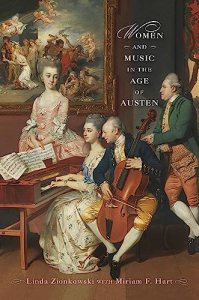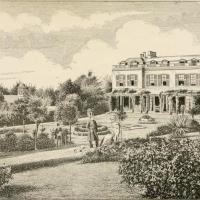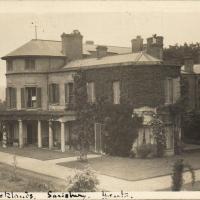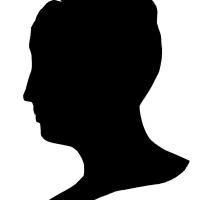Now Available: Women & Music in the Age of Austen (book)
It is with GREAT pleasure that I announce the publication – released on 15 December 2023 (in time for Christmas gifting) of our book, Women and Music in the Age of Austen (Bucknell University Press).
A couple of weeks ago I received my copy of the book:

The first time of seeing everyone’s essays, this day’s mail, long awaited, ended up being quite exciting. Part of the series “Transits: Literature, Thought & Culture, 1650-1850,” here is Bucknell’s description of our collection:
“Women and Music in the Age of Austen highlights the central role women played in musical performance, composition, reception, and representation, and analyzes its formative and lasting effect on Georgian culture. This interdisciplinary collection of essays from musicology, literary studies, and gender studies challenges the conventional historical categories that marginalize women’s experience from Austen’s time. Contesting the distinctions between professional and amateur musicians, public and domestic sites of musical production, and performers and composers of music, the contributors reveal how women’s widespread involvement in the Georgian musical scene allowed for self-expression, artistic influence, and access to communities that transcended the boundaries of gender, class, and nationality. This volume’s breadth of focus advances our understanding of a period that witnessed a musical flourishing, much of it animated by female hands and voices.
Published by Bucknell University Press. Distributed worldwide by Rutgers University Press.”
Here are the chapters, to tempt you, Dear Reader, into taking a look at the book:
Illustrations
Table
Acknowledgements
Abbreviations
Introduction: “It was all in harmony”: Musical Women in Austen’s Culture
Linda Zionkowski with Miriam F. Hart [our esteemed EDITORS]
Part I: Representing the Female Performer
Chapter 1: A Musical Room of Her Own: Musical Spaces in Jane Austen’s Novels
Pierre Dubois
Chapter 2: “Prima la musica”: Gentry Daughters at Play in Town, Country, and Continent, 1815-1825
Kelly M. McDonald
Chapter 3: Stage Fright: Female Musicians Crossing Musical Borders in Thicknesse’s The School for Fashion and Burney’s The Wanderer
Danielle Grover
Part II: Women and the Market in Music
Chapter 4: Women on the Title Page: Celebrity Endorsement of Musical Scores
Penelope Cave
Chapter 5: The Lady’s Choice: Women and the Purchase of Music through Subscription
Simon D. I. Fleming
Chapter 6: Female Musical Entrepreneurship in the Eighteenth Century
Alison C. DeSimone
Part III: Women as Critics and Fans
Chapter 7: Women as Quiet Critics
Jane Girdham
Chapter 8: Femininity and Foreignness in George Colman’s Farce, The Musical Lady
Leslie Ritchie
Chapter 9: Georgian Fangirls: Women and Castrati in Eighteenth-Century London
Jeffrey A. Nigro
Part IV: Women and the Bardic Tradition
Chapter 10: Anna Gordon and the Ballad Collectors
Ruth Perry
Chapter 11: Antiquaries, Female Harpists, and the Survival of the Bardic Tradition
Devon R. Nelson
Part V: Revisiting the Age of Austen
Chapter 12: “That Ecstatic Delight”: Gender and Performance in Adaptations of Sense and Sensibility
Gayle Magee
Chapter 13: “Here’s harmony!”: Music and Gender in Kirke Mechem’s Pride & Prejudice (2019) and Jonathan Dove’s Mansfield Park (2011)
Juliette Wells
Bibliography
Notes on Contributors
Index
Praise for Women and Music in the Age of Austen (included on Bucknell University Press’s website):
“Women and Music in the Age of Austen offers an expansive, lively, colourful view of the gendered musical practices of the eighteenth century and the Romantic period. These essays enrich our knowledge of the musical world of Jane Austen and Frances Burney while shining a spotlight on little-known female performers, critics, composers, consumers, collectors, fans, and musical entrepreneurs of the preceding decades.” ~Angela Esterhammer, author of Print and Performance in the 1820s: Improvisation, Speculation, Identity
“Finding inspiration in a broad range of sources, the volume reflects on women and their musical activities in Georgian England. A focus on Jane Austen and her novels moves in and out of the picture, amplified and receding against historical figures known and unknown. Through these essays by musically-informed literary scholars and musicologists, readers get a sense of the possibilities and desires of women engaged with music over a historical period that brackets the life of our beloved Jane.” ~Maribeth Clark, coeditor of Musicology and Dance: Historical and Critical Perspectives
“Music was important to Jane Austen, as her novels and letters attest, and women played a hitherto undervalued part in the musical world of her time. This sparkling and substantial collection of interdisciplinary essays illuminates Austen’s fiction and her age in many original and surprising ways.” ~Peter Sabor, coeditor of Jane Austen’s Manuscript Works
Preview the book on books.google.com., which pretty much allows readers to access EACH chapter!
My chapter, “‘Prima la musica,’ Gentry Daughters at Play,” deals with Emma Smith (1801-1876) and her sisters during the years of their musical education. Augusta Smith (1799-1836) was perhaps the most precociously talented woman – playing several instruments, a singer, and a musician with the ability to sight-read scores and improvise. Emma herself is the Smith “family historian” whom I follow – her letters and especially her diaries allow us in the 21-century to glimpse the life of young gentry daughters during the Regency, the prime years of Jane Austen’s publications AND their later dissemination (after Austen’s untimely death in 1817). The musical life of younger – middle – daughter, Fanny Smith (1803-1871), especially gives clues as to how daughters were introduced into society – first in the Country (around the home estate) and then in London. Fanny, for instance, lamented later in life that she never learned to READ MUSIC. Obviously, an “accomplishment” that she herself eschewed. This helps to prove how much responsibility each “student” took over her education – and also the musical leanings of certain siblings, although musicality certainly ran in families, as evidenced by those the Smiths met during the decade of 1815 to 1825.
Waterloo not only brought the Napoleonic Wars to an end, Waterloo opened the flood gates to the travellers who scoured the battleground for souvenirs, then moved east (France) and south (Italy) for a taste of culture and, especially, MUSIC.
To give readers a TASTE of the Smiths’ time in Italy, touched upon in “‘Prima la musica,’ Gentry Daughters at Play,” as an addition or furthering of knowledge, I suggest my online article, discussed in the blog post “Augusta in Italy,” entitled “Forget Me Not: Sealing Friendships from Italy 1823-1827“: presented on Academia.edu.
Women and Music in the Age of Austen is available from the usual retailers in hardcover, paperback, and ebook.
Half-a-Century Later
Recently, I have been doing a little work on putting up information for Isadore Albee’s diaries. I put up names today from the FIRST HALF of her 1862 diary.
Spending nearly fourteen years on researching Emma and Mary – their lives less of “an open book” than a tangle of information (and a great deal of tangled information!) that must be teased and sorted – has taught me useful “tricks” that are coming in handy with Dora’s diaries. But, oh!, the differences!
Mary Gosling and Emma Smith, two young English women, from families who were Quite Well Off Financially, are (literally and figuratively) half a world away from Isadore Albee, in the rural neighborhood of Rockingham and Springfield, Vermont. Isadore has the Connecticut River in place of the Thames – but it’s just not the same.
In 1860s Vermont, Dora’s trips take her to Derby (near the Canadian border) and into New Hampshire, there’s no London Townhouse to occupy, as with the Smiths and Goslings, where a “season” of entertainment, lessons, exhibitions, and friends may be enjoyed.
Dora works; she laments her need to work – or otherwise starve. At times, she seems to do paid millinery work (following in the footsteps of an elder sister); but she also seems to work (at times) in a local store and “living in” for a short period with local families. This, while trying to educate herself.
Emma and Mary might have sewn – usually items distributed among the poor of their parish – but they didn’t have a need to account for monies coming in AND going out (though Emma did, at times, keep tallies of her spending). The Albees were on a far lower economic stratum than the Smiths and Goslings. And Vermont, in the 1860s, was no 1810s Essex or Surrey, never mind London.
A major difference, to me as a dispassionate observer, is the differences in their diaries. If I thought Mary and Emma had small diaries (about the size of an 8 x 5 index card), Dora’s diaries are even tinier! A half-a-century, and half-a-world away (United Kingdom versus United States), the personal items of three “twenty-somethings” are as different as their writing implements: Emma Smith, for instance, wrote the bulk of her diary (all the entries) in INK. Tougher on her, I’m sure, but easier on me as her transcriber. Dora Albee’s entries are totally in pencil. The most noticeable difference comes in SPELLING. Emma’s is consistent, and usually correct. Dora’s tends to have a phonetic basis for some words, though others are probably just too-hastily-written. In either case, her diary is more of a challenge, when transcribing, to make out words, to make sense of sentences.
Some words, however, live in the ear – “surpose” must be indicative of her pronunciation of suppose. And one phrase, “down street”, is used by locals in areas of central Vermont to this day. Such was never a phrase I heard (or used), here in northern Vermont.

But it wasn’t all work for Dora Albee. She mentions a “singing school”; and a concert or two at which she and other “singing” students performed. She comments, too, on the typical Vermont weather that still exists in my own life – the crusty snow in winter, the muddy paths in spring. There are sledding parties and sleigh rides, music and plays, visits to and from young friends. She mentions illness and death much more often than Emma – for instance, Dora’s sister (and later Dora herself) join in the “watch” over the ill, much like Mary Lloyd Austen “watched”, with Cassandra Austen, during Jane Austen’s last illness in Winchester.
So, although far apart, in distance and time, some things – especially for women – remain remarkably “same”. Especially, the written notices of marriages, babies, illnesses, and deaths. Dora had it tougher, experiencing the deaths of young men and women in her social circle. And she knew so many young men who left the comfortable arable acres and woods of Vermont for Civil War battlefields and military camps.
Isadore Albee’s Civil War Diaries
Whether Isadore Albee gets her own blog or not, I want to talk about her – and will do so here.
A very recent purchase, the Civil War diaries of Isadore Albee (her father spelled his name Allbee), is EXACTLY the project I have long sought. Past purchases have tended to forward my main research, into the Smith and Gosling family — presented online as “Two Teens in the Time of Austen” because Emma Smith married James Edward Austen (later Austen Leigh) AND Mary married Emma’s eldest brother Sir Charles Joshua Smith, baronet.
Isadore – I tend to think of her as ‘Dora‘ (which may or may NOT be what she called herself; I’m still hoping to find that out) – was a “known object” when I purchased the diaries. The seller’s ad had boasted a plethora of characterful excerpts, which caught my eye and fired my imagination. Dora wrote of her everyday life during a period, 1862 through 1871, important to American history, a period of change and national turmoil. That “era” called to me, as it does to many.
Dora is a female diarist. Typically, men‘s war diaries have been preserved for posterity, so Dora’s are a welcome breath of fresh air. Dora is young – she records her 21st birthday in May, 1862. It’s recorded as a day of “no preasants” (sic) and given over to the first effects of “scarlettina.” Dora’s typical “luck”….
The BIG inducement, compounding “female diarist” and “Civil War era” into a trifecta: Dora lived in Springfield, VERMONT. My home state!
I’d *LOVE* to direct you to a new blog. But I may simply delete what I began on WordPress. I liked the blogging platform, as it was; I despise what it is now.
I haven’t yet made up my mind if Dora will somewhat “share” space with my Two Teens or not. It’s a departure in so many ways, AND YET somewhat related – in terms of being a research project.

After fourteen years of researching English diaries and letters, finding related biographies and related artwork, visiting estates now turned into schools or cut into condominiums, there are “challenges” in working on a set of diaries from Vermont. The Smiths & Goslings were important people, wealthy people; they owned estates; they lived in London during “the season.” Traces of their faded tracks pop up in newspapers. The popular literature of their day, monthly items like Gentleman’s Magazine and the Annual Review, are go-to places for a wealth of information on their (wide) circle of English landed gentry.
For Dora‘s diaries, I’m down to a small local newspaper (not digitized) and the U.S. Census. Dora’s friends and presumed neighbors are sometimes only mentioned by first name; it’s my assumption that they are young ladies, like herself.
Mary and Emma, on the other hand, always cite people in a VERY formal manner. Young friends (and even relatives) always are designated by first and last name. Only their own immediate family members rated a first-name-only. Finding information on the many, many servants of their world has been tougher; they, too, could be first name OR last name only.
To confuse the average reader, though, those next-door neighbors were interrelated even before Mary’s marriage to Charles in 1826.
Emma, for instance, differentiates between her sister Charlotte and Mary’s sister Charlotte Gosling. Family also had two Carolines (Caroline Mary Craven Austen and Caroline Wiggett [later Caroline Workman]). In later years, there were not only Mrs. (Augusta) Smith and her eldest daughter, Augusta; but Mary had a daughter named Augusta. Emma had a daughter named Augusta. Fanny had a daughter named Augusta….
You get my drift…. A LOT of duplicate names. Even marriages brought in new but similarly-named family members. Emma’s sister Fanny changed her name from Smith to Seymour a few months before their new sister-in-law, Frances, changed her name from Seymour to Smith. To confuse things, Frances seemed to have been called ‘Pam,’ at least in her girlhood, by her family; though the Smiths always referred to her as Frances. Whereas Fanny was never known as Frances, except in a very youthful letter. Fanny’s husband, the Rev. Richard Seymour, referred to his cousin (and eventual sister-in-law) as “Dora K.” because he also had a sister Dora. Cousin Dora Knighton was the daughter of Sir William Knighton – an important personage known to the Prince of Wales / Prince Regent / King George IV. Lady Knighton’s first name was Dorothea, thus the sprouting of other ‘Doras’. Though, of course, not for my ‘Dora’ Albee.
I’ve already begun a family tree for Dora: her only brother died when a toddler, and she talks most about her elder sister, Jane, and younger sister, Sophia. I have yet to figure out if “Bessie” in 1862 is “Lizzie” in 1870, and whether both refer to her sister Elizabeth. The family tree includes eldest sister Gratia (who married in 1850 and moved to Iowa a decade or more ago) and one who married only in 1860, Ellen.
But I’m used to sorting out people. In “Two Teens,” there are THREE Emma Smiths! Besides my diarist, Emma Smith (Emma Austen), there is: “Aunt Emma” (who never married), Mrs. Smith’s youngest sister, and great aunt Emma Smith (later Lady Dunsany), a sister to grandfather Joshua Smith. Lady Dunsany married late in life, and, from what I’ve found, was as loquacious as Miss Bates (in the Jane Austen novel, Emma).
My prime interest in the Civil War diaries is Isadore Albee, herself.
Life & Times of Georgiana Jane Henderson
You know that I *LOVE* to hear about new books, but to hear of one from a writer with whom I’ve been in correspondence has to be extra special.
Susan Bennett‘s new book is A Thankless Child: The Life and Times of Georgiana Jane Henderson (1771-1850). Her prior publication, ‘I awleis admired your talent’: The artistic life of Georgiana Jane Henderson (née Keate) (1771-1850) (MA dissertation, published in Germany) also presents aspects in the life and times of Georgiana Keate Henderson.

I first learned about Georgiana five years ago; her diaries mention some Goslings!
In an early email, Susan mentioned a print, based on work by George Keate (Georgiana’s father), of HALL’S LIBRARY, Margate (← click to see it at The British Museum). Mrs. Gosling did have a book by Keate in her library (her book plate being attached). And the names attached to an entry in Georgiana Henderson’s diary all point to Mrs. Gosling (née Elizabeth Houghton), my diarist Mary’s paternal grandmother: “Mrs. Gosling with Mr. and Mrs. Gregg brought Miss Norford from Langley about one o’clock – they left us again at three“. The entry dated: 15 September 1803.
Mrs. Gregg would be Mrs. Gosling’s daughter, the former Maria Gosling, accompanied by her husband, Henry Gregg. Miss (Annabella) Norford shows up twice in Gosling letters, and does seem typically in company with this Mrs. Gosling. Langley was the Gosling’s old family estate. (William Gosling, Mary’s father, much preferred his own estate – Roehampton Grove – to this estate of his parents.)
There is a slim possibility that “Mrs. Gosling’s” is Maria Gregg’s sister-in-law, Eliza (mother of my diarist Mary Gosling), who would live only another three months….
You can imagine how *thrilled* I was to hear of these tidbits!
I’m only now thinking: Miss Norford, friend of Georgiana, must have been visiting the Goslings (at Langley) [that a given] and was perhaps being brought to Georgiana’s home for a stay (so that only Mrs. Gosling & the Greggs departed). A lady did not travel alone, and from what I’ve read of coaching inns and coaching yards during the Georgian period, _I_ would be happy to have company (male or female) for any “change horses” stops.
Of course, it is possible that ALL traveled back to Langley. To know the whereabouts of Annabella Norford may be answered by Susan’s book!
Susan was hoping that the Goslings had perhaps mentioned Mrs. Henderson – but I’ve so far uncovered little “Gosling” archives (especially in comparison to the Smiths). Revisiting old emails makes me wish I could find more, and earlier, items.
Susan was lucky enough to find references to Georgiana Henderson in the superb online diary of Fanny Chapman.
In an early invitation to correspond, Susan Bennett included this vivid description of her research subject:
“Georgiana was the only daughter of George Keate, an amateur artist and poet, who was known to most of the artistic and literary circles of the day. He (and therefore Georgiana) could count David Garrick, Angelica Kauffman, John Russell, Charles James Fox and Robert Adam among their close circle of friends. Georgiana married John Henderson (also an amateur artist) who was an early patron of J M W Turner and Thomas Girtin.“
The diaries I work with are similar to those Susan used as a source: Visits and Visitors. I can’t wait to read her biography of Georgiana Jane Henderson. Buy it thru several sources: Amazon, Amazon.uk [=sites offer a preview of the book], or Lulu.
Slowly Building those Blogs
Quick note on two new pages — in two new blogs:
My Ladies of Llangollen blog has had the writings of Marion Harland added — check it out
And my newest blog, where I hope to hear about some new books, and (sooner or later) discuss some old books: I call it Georgian Gems, Regency Reads & Victorian Voices — it’s about published history, diaries, letters, biographies — there’s only two books at present. Help me add to it! The “ABOUT” will hopefully fill you in on the types of books you’re likely to find there.


















